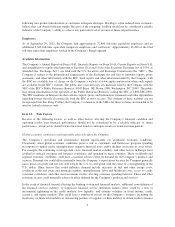Apple 2012 Annual Report Download - page 20
Download and view the complete annual report
Please find page 20 of the 2012 Apple annual report below. You can navigate through the pages in the report by either clicking on the pages listed below, or by using the keyword search tool below to find specific information within the annual report.The Company uses derivative instruments, such as foreign currency forward and option contracts, to hedge
certain exposures to fluctuations in foreign currency exchange rates. The use of such hedging activities may not
offset any or more than a portion of the adverse financial effects of unfavorable movements in foreign exchange
rates over the limited time the hedges are in place.
The Company is exposed to credit risk and fluctuations in the market values of its investment portfolio.
The Company has not recognized any significant losses on its cash, cash equivalents and marketable securities,
but could experience significant declines in the market value of its investment portfolio. Given the global nature
of its business, the Company has both domestic and international investments. Credit ratings and pricing of these
investments can be negatively affected by liquidity, credit deterioration, financial results, economic risk, political
risk, sovereign risk or other factors. As a result, the value and liquidity of the Company’s cash, cash equivalents
and marketable securities could decline and result in a significant impairment.
The Company is exposed to credit risk on its trade accounts receivable, vendor non-trade receivables and
prepayments related to long-term supply agreements, and this risk is heightened during periods when economic
conditions worsen.
The Company distributes its products through third-party cellular network carriers, wholesalers, retailers and
value-added resellers. A substantial majority of the Company’s outstanding trade receivables are not covered by
collateral or credit insurance. The Company’s exposure to credit and collectability risk on its trade receivables is
higher in certain international markets and its ability to mitigate such risks may be limited. The Company also
has unsecured vendor non-trade receivables resulting from purchases of components by outsourcing partners and
other vendors that manufacture sub-assemblies or assemble final products for the Company. In addition, the
Company has made prepayments associated with long-term supply agreements to secure supply of inventory
components. As of September 29, 2012, a significant portion of the Company’s trade receivables were
concentrated within cellular network carriers, and its non-trade receivables and long-term supply agreements
were concentrated among a few individual vendors located primarily in Asia. While the Company has procedures
to monitor and limit exposure to credit risk on its trade and vendor non-trade receivables as well as long-term
prepayments, there can be no assurance such procedures will effectively limit its credit risk and avoid losses.
The Company could be impacted by unfavorable results of legal proceedings.
The Company is subject to various legal proceedings and claims that have not yet been fully resolved and that
have arisen in the ordinary course of business, and additional claims may arise in the future. Results of legal
proceedings are subject to significant uncertainty and, regardless of the merit of the claims, litigation may be
expensive, time-consuming, disruptive to the Company’s operations, and distracting to management. In
recognition of these considerations, the Company may enter into arrangements to settle litigation.
Although management considers the likelihood of such an outcome to be remote, if one or more of these legal
matters were resolved against the Company in a reporting period for amounts in excess of management’s
expectations, the Company’s consolidated financial statements for that reporting period could be materially
adversely affected. Further, such an outcome could result in significant compensatory, punitive or trebled
monetary damages, disgorgement of revenue or profits, remedial corporate measures or injunctive relief against
the Company that could materially adversely affect its financial condition and operating results.
The Company could be subject to changes in its tax rates, the adoption of new U.S. or international tax
legislation or exposure to additional tax liabilities.
The Company is subject to taxes in the U.S. and numerous foreign jurisdictions. Current economic and political
conditions make tax rates in any jurisdiction, including the U.S., subject to significant change. The Company’s
future effective tax rates could be affected by changes in the mix of earnings in countries with differing statutory
19
























